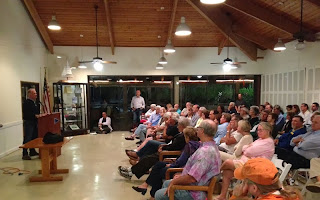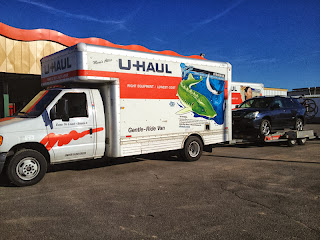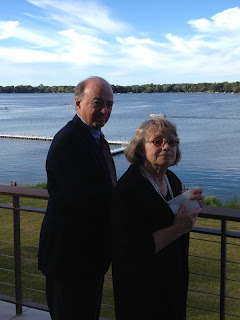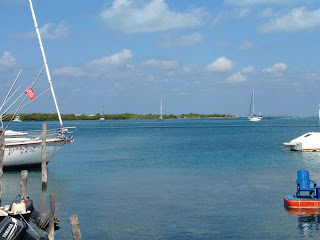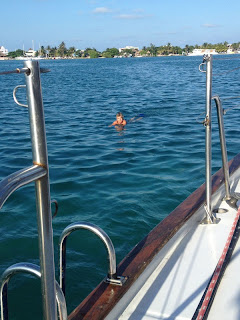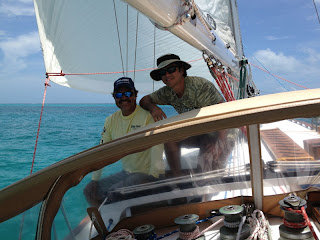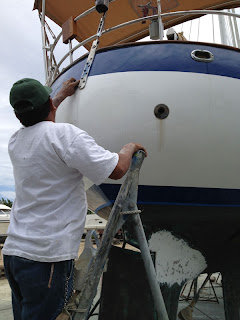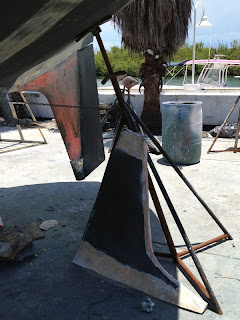Whale shark tours have become a huge business in Isla Mujeres in the last five or so years. It used to be that tourists cleared out in May when the rainy season started, but then someone noticed that whale sharks were migrating north through the Yucatan Channel during the summer months. Now there is no noticeable decline in tourism until the whale sharks move on near the end of August, before what the local people call “
septihambre” (hungry September).
Longtime friends of ours on the island have taken advantage of this new opportunity. Ariel, who has been conducting snorkeling and fishing trips for many years, now does mostly whale shark tours from June through August. Wbeymar (pronounced “Way-mer”), who owns Brisas Grill, where our good friend Juan Gomez works, now has a fleet of two whale shark tour boats, with plans to add another one next season. Both have been asking us during summer visits to go on their tours with them, but we never have, up until last week Wednesday, that is.

We were hearing reports from guests at El Milagro Marina that the number of whale sharks out in the viewing area, which is treated as a national park by Mexico, was diminishing, so we decided we had better go before it was too late. Wbeymar had told us he would give us a no-commission deal of 850 pesos ($70) each, which was better than Ariel’s offer, even with his promise to limit the number of people to just four in order to increase in-water time, so we went with Wbeymar.
Nan and I showed up at Brisas Grill at 7:30 that morning, thinking the tour would be leaving at 8:00 and that we would have time to get some coffee and breakfast. Juan and his co-worker Victor were just setting up tables and chairs. After a half-hour, Nan gave up waiting for coffee and went to the Oxxo (Mexico’s version of 7-Eleven) across the street for a cup. I toyed with the underwater camera our friend Scott from El Milagro Marina had lent me. Soon, Wbeymar’s first tour boat, Lizardo, arrived at the pier behind the restaurant. Wbeymar himself showed up a little while later and told us the tours leave at 8:30, not 8:00. Juan served us coffee, orange juice and slices of a breakfast cake. Other groups started to filter in. We counted about twenty by 8:30. We hoped we wouldn’t all be packed into a single boat, but then Ana Carina, Wbeymar’s second tour boat, arrived at the pier. Moses, the tour leader, broke us up into two groups of ten each and led us to the boats. I urged Nan to take a seat near the bow of our designated boat, Lizardo, to minimize the spray that would result from blasting through the waves at high speed.

The combination of the north-flowing current and the easterly winds made for a very rough one-hour ride out to where the whale sharks were feeding, about twenty miles northeast of Isla Mujeres. People near the back of the boat were drenched by the time we spotted the cluster of at least fifty other boats bobbing around a large school of whale sharks and slowed to join them. In between the boats were groups of snorkelers and some really large dorsal and tail fins. A whale shark coasted under the bow of our boat, just below the surface, its head at least three feet across. Nan and I looked at each other and mouthed, “Wow!” I couldn’t wait to jump in and see one up close. Nan was not so sure.
Moses explained that park rules required us to wear standard orange life preservers and to let only two people into the water at a time, plus a guide. He went over the side in his mask, snorkel, and fins, and beckoned the first two people, a couple, to join him. The boyfriend went in first and then the girlfriend jumped in practically on top of a passing whale shark. Those of us watching from the boat were alarmed for her safety, but we could hear her laughing through her snorkel. Brave girl!
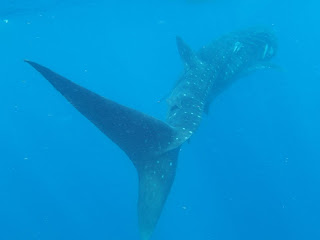
Nan decided to sit out the first round, so I was paired up with Kim, a pediatrician and part-time Isla Mujeres resident. When it was our turn, we paddled around with Moses for a while without seeing anything, until shouts of excitement nearby alerted us. I put my head underwater and looked in the direction of the shouts. A huge open mouth was coming right at me. I didn't have time to raise the camera before swimming out of the way, but I was able to keep up with the whale shark, as it glided slowly along straining the water for plankton, and take a few photos before I tired out. We had been told not to touch the whale sharks, but it took an effort to stay out of their way and not get whacked by their enormous tails as they glided past, seemingly oblivious to the many people swimming in their presence.

Nan decided not to let the opportunity pass and joined me for the second dive. We didn't see as many whale sharks as I had seen on the first dive, but she was still impressed. I could tell by how wide her eyes were behind her dive mask. Manta rays, which feed on the same plankton, had been reported in the area, some even leaping high out of the water, but we did not see any that day--our excuse to return someday for a second tour.
The trip back to the island was much smoother, but the spray was more intense. We were all soaking wet, so it didn't matter. Miguel, our boat captain, stopped outside the reef at Anvil Rock to let us snorkel for a while. The water was too rough for Nan but I dove in to see what was there. From twenty feet above, the bottom didn't look like much, just the usual green-tinted rocks and corals, but when I did a surface dive and went to the bottom, everything changed. Colorful fan coral, staghorn coral, and every other coral type covered the rocks, and striped sergeant major fish and lavender-colored angel fish swam in and out of every crevice. Now it was my eyes that were wide. I wished I had remembered the camera. A few more deep surface dives and I was too tired to hold my breath anymore.

Miguel pulled the boat around to the shallow, sandy-bottomed waters of Playa Norte and anchored. Many of the other whale shark tour boats were already there, and the party had begun. Loud music, skimpy bikinis, and bottled beer were everywhere. Moses and Miguel served up fresh-made shrimp ceviche and cold beer. Nan ate a plate of ceviche and tortilla chips, and then waded through the water to shore, her pack over her head, for her afternoon Spanish lesson downtown. I stayed with the boat for the ride back to our starting point at Brisas Grill, happy that we had finally taken a whale shark tour.
If you've never done it and you happen to be in the western Caribbean during the summer months, you owe it to yourself to snorkel with these amazing creatures, earth's largest fish, before their migration route changes and you miss the chance.


 Raising Charlie: The Lessons of a Perfect Dog
Raising Charlie: The Lessons of a Perfect Dog

























